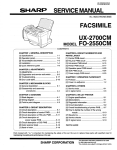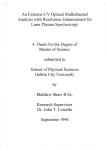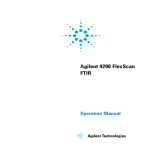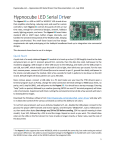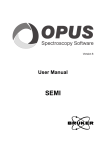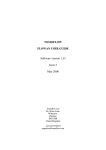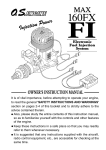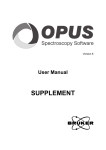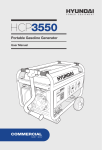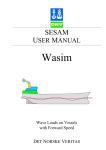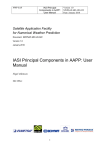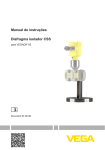Download Dear Editor, The manuscript “Source brightness fluctuation
Transcript
Dear Editor, The manuscript “Source brightness fluctuation correction of solar absorption Fourier Transform mid infrared spectra” has been revised according to the referees’ comments. Comments to Referee #1: (1) Introduction: The description of the effects due to variable DC is vague: "...intensity fluctuations can distort the fractional line depth in FTIR". It would be more appropriate to describe the primary effect as ILS distortion due to an additional apodisation which results from the variable atm transmission during interferogram recording. We agree with the referee and included this aspect in the manuscript. Æ Page 445, line 12: inserted “The distortion of the fractional line depth is due to an additional apodisation which results from the variable source intensity and distorts the instrumental line shape (ILS) .” (2) Please give more details on the MCT detector: Do you use photoconductive or photovoltaic detectors? In this study we use a standard Bruker photoconductive MCT detector. This has been mentioned in the introduction on page 446, line 10: “… measured with a photoconductive MCT detector.” For clari- fication we now mention the photoconductive MCT detector also in Sect. 2. Æ Page 447, line 11: changed “Measurements with the MCT detector…” to “Measurements in the mid infrared spectral region were performed using a photoconductive MCT detector at low signal intensity in order to avoid non-linearity effects.” (2b) What is the origin of the offset voltage? (A basic preamp circuit diagram would help.) The offset is due to a constant voltage, which leads to a current flow through the detector element as described on page 446, line 12. The used detector is a standard Bruker photoconductive MCT detector. A circuit diagram of the preamplifier of this detector can be found in each Bruker User’s Manual. Thus, we did not include a preamp circuit diagram into the manuscript; instead we now refer to the Bruker User’s Manual with a footnote in the manuscript Æ Page 446, line 12: inserted footnote “A preamplifier circuit diagram can be found in the 120M Bruker user’s manual.” (2c) Is the offset primarily of electrical origin, or is instrumental selfemission relevant as well? See comment (3) (2d) To which extent would the suggested methods be affected by nonlinearity effects? Nonlinearities have an effect on the interferogram recording. However, for the solar absorption measurements in this manuscript we use low signal intensities to avoid non-linear effects as mentioned on page 447, line 11f. (2e) How stable is the deduced offset as function of time? See , comment (7), referee #2 (3) Would instrumental self-emission inflict a loss on the methods proposed? (Selfemission might contribute to both the DC and AC parts of the interferogram, but will not scale with the atm transmission changes)? Concerning instrumental self-emission two cases have to be distinguished; instrumental self emissions, which result from emissions in front of the interferometer block and self emissions which result from emissions behind the interferometer block. Self emissions in front of the interferometer block are mainly blocked by two apertures, the first one in front of and the second one behind the interferometer block. Instrumental self emissions behind the interferometer block contribute to the offset but will be corrected by the presented method. We believe that instrumental self emissions do not significantly inflict a loss on the proposed method. Furthermore, due to the high temperature of the sun compared to the instrument the contribution from self emissions will be very small. (4) Why does the first approach of determining the offset by using a measurement taken with an InSb detector works so properly? We should expect that the interferometer’s modulation efficiency depends on wavenumber. Since the InSb spectral responsivity differs from the MCT, even identical filter and optical settings will not guarantee that the same modulation efficiency is found. Which filter bandwidth do you recommend (/did you use in your setup) for this exercise? Finally: the InSb longwave response cut is located at higher wave numbers - how can you cover the MCT spectral region of interest (700 - 1300 cm-1) with an InSb reference measurement? We agree with the referee in this point. The modulation efficiency is dependent on the wavelength with typical values of ~50% in the UV to ~90% in the mid infrared. The impact of different detector responsivity within the filter region is in our point of view small and only has a small impact on the determination of the modulation efficiency and a even smaller impact on the calculation of the offset. The same argument applies in our opinion to the change in the modulation efficiency towards smaller wavenumbers. To our experience the modulation efficiency does not drastically change between 1900-2700cm-1 and 900-1300cm-1. These assumption are confirmed by comparing the offset calculated with the modulation efficiency to the offset calculated with the second method (Sect. 3.1). The small error in the offset does not have a significant impact on the method as now showed in a short sensitivity study in Sect. 3.1 (see comment (7)). For our measurements of the modulation efficiency we used a filter with a filter bandwidth from 1900 -2700cm-1. This is now mentioned in the manuscript. Æ Page 447, line 18: inserted “(bandwidth: 1900-2700cm-1)” (5) Application of the OPUS running mean function: Do you apply the OPUS smoothing function with a broad data point window just once? We applied the smoothing function twice with a data point window of 1000. This is now mentioned in the manuscript. Æ Page 448, line 14: deleted “(mean over n datapoints)” Æ Page 448, line 15: inserted “The smoothing is accomplished by applying twice a running mean with a data point window of 1000.” (6) Did you alternatively try repeated smoothing runs with narrower kernel widths instead? Is the result identical? If not, which approach seems preferable? How do you determine the required amount of smoothing? Is this choice critical? We applied the same smoothing in the MCT examples (3.1) as well as in the InGaAs study (3.2) and prove that the choice of the smoothing is suitable for the SBF correction. For clarification we now mention the setup of the smoothing also in Sect. 3.2 Æ Page 451, line 13: inserted “For generating Ismooth the OPUS smoothing function is applied twice with a data point window of 1000.” In addition we tested the impact of different kernel widths (2x5000, 2x1000, 3x500, 4x100, 5x10). The choice of the different kernel is not critical as long as the smoothing does not affect the modulation frequencies. A good lower boundary is 500 data points. This is now mentioned in the manuscript. Æ Page 448, line 17: inserted “The choice of the data point window is not critical as long it does not affect the modulation frequencies. Here, a reasonable lower boundary for the window size is 500 data points” (7) Section 3.1: It is shown that both methods indicate very similar values for the offset. How sensitive the SBF correction is wrt errors in the offset determination? It would be interesting to include a short sensitivity study to understand how accurately the offset determination needs to be. (I would expect that the correction stays largely intact even if we allow some uncertainty in the offset determination. You could check this by applying different offsets in the retrieval study underlying Fig. 4) We agree with the referee that a short sensitivity study to understand how accurately the offset determination needs to be is interesting for the manuscript. We performed such a sensitivity study based on the examples of ozone total column concentrations underlying Fig. 4. The sensitivity study shows that the impact of errors in the offset increases when the influence of SBF on the interferogram increases. However, it also shows, that small errors in the offset do not have a significant impact on the total column retrieval. Æ Page 450, line 29: inserted “Based on the three examples in Fig. 4 we now study the impact of errors in the determination of the offset on the retrieval of O3 total column concentrations. In Tab. 2 the total column concentrations of O3 (and their percentage deviations to the AC reference value) for the three examples and for different applied offsets are presented. In the undisturbed case (1) the offset does not affect the O3 retrieval. However, the impact of errors in the offset on the retrieval increases in the second (2) and third (3) case. Large errors in the offset (8.5%) lead to an error of up to 3.1% in the total column concentration. Small errors in the offset determination on the other hand do not significantly change the total column concentrations (an error of 1.3% in the offset in case (3) leads to an error of less than 1% in the total column concentration) .” Æ Inserted Table 2. Æ Inserted caption, Table 2: “Impact of errors in the offset determination on the retrieval of O3 total column concentrations; percentage deviations are related to the initial value (6.6877x1018mol/cm2) calculated from the undisturbed AC spectrum. Numbers are given in 1018mol/cm2.” (8) Technical / phrasing / typos: Abstract, line 12 ff "The analysis of trace gas concentrations ... is fundamental." It is not clear to me what the authors want to express with this statement. (This phrase is repeated on page 446, line 7). We wanted to express that a SBF correction of spectra in the mid infrared spectral region is important to improve the data quality. We omitted the sentence in the abstract and changed the corresponding sentence on page 446. Æ Abstract, line 12: deleted “The analysis of trace gas concentrations…” Æ Abstract, line 13: inserted “in the mid infrared spectral region” Æ Page 446, line 7: changed “However, in the mid infrared spectra region (…) the analysis of many important trace gases (…) is fundamental.” to “However, the application of a SBF correction to spectra in the mid infrared spectral region (700-3800cm-1) for the analysis of many important trace gases, such as O3, is reasonable. Page 450, line 11: sicnificantly -> significantly Æ This aspect has been corrected in the manuscript Section 3.1: I assume that the AC IFG in Fig 3 is deduced from the DC IFG numerically (no parallel digitization of AC and DC ifgs, as also possible with the Bruker acquisition in principle). Please state somewhere where this AC ifg comes from. The AC interferograms are numerically deduced from the DC interferograms. This is now mentioned in the manuscript. Æ Page 448, line 24: inserted “In Sect. 3 DC interferograms are compared to SBF-corrected interferograms and AC interferograms. The AC interferograms are numerically deduced by subtracting the smoothed interferogram from the raw interferogram within OPUS. Fig. 3: Please mark the zero level for both the black and red spectra, e.g. by dashed lines. Æ Fig. 3: zero levels have been inserted Please state that the spectra have been shifted along the ordinate for clarity. Æ Fig. 3, caption: “SBF correction of a solar absorption MCT interferogram; (a) AC interferogram, (b) DC interferogram, (c) SBF-corrected interferogram, (d) AC spectrum and SBF-corrected spectrum (shifted along ordinate), (e) residual plot of AC spectrum and SBF-corrected spectrum.” Comments to Referee #2: (1) Introduction, page 446, line 26ff: "We present a method of source brightness fluctuation correction, which is independent of the measured wavelength …" I do not understand this sentence. Why should an SBF correction be wavelength dependent, apart from the fact that different wavelength ranges are covered by different detectors? If this is the point you want to make, then I suggest to replace "independent of the measured wavelength" by "independent of the used detector". We want to express that the SBF correction is independent of the used detector. This has been changed in the manuscript. Æ Page 446, line 25: replaced “measured wavelength” by “used detector” (2) Page 446, line 29: "In addition, we compare our SBF correction method to the method presented by Keppel-Aleks et al. (2007)" I do not agree with this statement. The SBF correction method presented in this paper deals with the unknown offset of MCT detectors, but the comparison is done for offsetfree InGaAs detectors in both cases. See also comments on section 3.2 below. We assume a misunderstanding here; In the introduction we distinguish between the SBF correction, which is the reweighting of the interferogram according to Eq. 1, and the removal of the offset (Page 446, line18). Our SBF correction method (the reweighting of the interferogram) differs from the approved method used in previous studies (Keppel-Aleks) as described on Page 445, line24ff and Page 448, line 11. Thus, Sect. 3.2 is considered as a test of our SBF correction method as mentioned in the abstract (“For a comparison with previous studies, we apply our source brightness fluctuation correction…”). For clarification we changed the word choice on page 446, line 29: Æ Page 446, line 29: changed “In addition, we compare our SBF correction method to the method (…)” to “In addition, we test our SBF correction method by comparing it to the method (…)”. (3) Page 447, line 10ff: Please indicate which spectral range exactly is covered by which detector for the two spectrometers. A table would be helpful. We agree with the referee and added a table with the spectral range of each detector in the two spectrometers Æ Page 447, line 14: inserted “The spectral coverage of each individual detector used in the IFS125HR and the IFS 120/5M during solar absorption measurements is shown in Tab. 1” Æ Inserted table with spectral range of each detector and instrument Æ Inserted table caption: “Spectral range of different detectors used during solar absorption measurements with the 120/5M and 125HR instrument. (4) Section 2, Method: How accurate is the determination of the offset? What are the requirements for the accuracy of the offset determination in order to get a good SBF correction? How accurate is the determination of A? Does the interferogram sampling have an impact of the determination of A (e.g. if the interferogram maximum and/or minimum is not hit by a sampling point)? The interferogram sampling only has a small impact on the determination of A and an even smaller impact on the calculation of the offset. The impact of small errors in the offset is now included in the manuscript in terms of a short sensitivity study in Sect. 3.1. This study shows that small errors in the offset do not significantly affect the method. Æ see comment (7), referee #1 (5) How do you determine B? Is it determined in the vicinity of the interferogram peaks? How do you make sure that B is measured at the same source brightness as A in presence of source brightness fluctuations? A and B should be measured right at the position of the interferogram’s centerburst to avoid errors in the offset due to a change in the source brightness. This is now mentioned in the manuscript. Æ Page 448, line 1: inserted “The variables AMCT and BMCT both need to be determined in the vicinity of the interferogram’s centerburst to avoid errors in the offset due to a change in the source brightness.” (6) I assume that the determination of O using equation (6) could be easily done with two different, but stable sources, e.g. by looking at the sun under clear sky conditions and then looking at a room temperature target. What would be the result of such a characterization measurement? How does it compare to the methods presented in the paper? We agree with the referee, that the proposed method can in principle be used to determine the offset. The method would also lead to two equations and two variables (modulation efficiency and offset) which can then be used to determine the offset following equation (6). It is also possible to use a blackbody with different intensities to determine the offset following equation (6). However, our intension with the second method is to use available solar absorption measurements to determine the offset without further measurements. (7) How stable is the offset in time? Is it sufficient to determine the offset once using dedicated measurements or must it be determined regularly during measurement campaigns? Using method one to determine the offset implies a regular check of the modulation efficiency of the instrument, since the offset is dependent on the modulation efficiency. This is now mentioned in the manuscript. Æ Page 448, line 1: inserted: “Since the offset is dependent on the modulation efficiency of the instrument, the modulation efficiency has to be determined regularly to avoid errors in the offset due to a change in the instrument alignment. Using method two, the offset is independent of the instrument alignment. We now mention this aspect in the manuscript. Æ Page 448, line 9: changed “This method is independent of using an additional detector…” to “This method is independent of the alignment of the instrument” (8) Page 448, line 11ff: Here you describe the SBF correction using Eq. 1. How do you handle the offset during the processing? Is it subtracted beforehand or is it subtracted within the OPUS software? This is not clear. The offset is subtracted with the OPUS software before applying the SBF correction. We now mention this aspect in the manuscript. ÆPage 448, line 13: inserted “the offset is subtracted from the raw interferogram using the OPUS calculator, Æ Page 448, line 14: inserted “again” (9) Page 448, line 14: "mean over n datapoints" How large is n? We applied the smoothing function twice with a data point window of 1000. This is now mentioned in the manuscript. Æ Page 448, line 14: deleted “(mean over n datapoints)” Æ Page 448, line 17: inserted “The smoothing is accomplished by applying twice a running mean with a data point window of 1000.” Have you tried different values for n? See comment (6), referee #1 (10) Page 448, line 15: "The procedure has the advantage that the correction is independent of the measured spectral region and it can be applied automatically and instantaneously together with the measurement process." 1) Advantage: An advantage when compared to what? We want to express that the procedure is independent of the used detector. For clarification we changed the word choice in this sentence. Æ Page 448, line 15: deleted “… has the advantage that the correction …” 2) Independent of the measured spectral region: Again, I guess you mean it is independent of the used detector (the dependency on the spectral region is then implicit, because different detectors are used in different spectral regions). Æ Page 448, line 16: replaced “measured spectral region” by “used detector” 3) How do you handle the offset in this automatic application? Is the offset also determined automatically? If yes, which method is used? Please clarify. We mentioned on page 448, line 16 that “The procedure can be applied automatically …”. In this study the offset has been removed manually. (11a) Section 3.1, Fig. 3, left (interferograms) At page 447, line 10; you state that the instrument has measured in DC mode. In figure 3, however, you present AC and DC data. Please explain how the AC data has been generated. The AC interferograms are numerically deduced from the DC interferograms. This is now mentioned in the manuscript (see also comment (8), referee #1) Æ Page 448, line 24: inserted “In Sect. 3 DC interferograms are compared to SBF-corrected interferograms and AC interferograms. The AC interferograms are numerically deduced by subtracting the smoothed interferogram from the raw interferogram within OPUS. (11b) The interferogram intensity is given in %. What is the reference, i.e. what corresponds to 100 % (same question for Fig. 4)? The interferograms intensity is the percentage efficiency of the instrument’s analog to digital converter. This is now mentioned in the manuscript. Æ Page 449, line 6: inserted “The interferograms’ intensity is described as the percentage efficiency of the instrument’s ADC (analog-to-digital converter). (12) (13) Section 3.1, Fig. 3, right (spectra) Please indicate where the zero level is. A difference plot showing the residual between the two spectra may be instructive. Figure 3 is densely packed with information. I suggest to enlarge the plots and to use the full width of the page for the interferograms as well as for the spectra (and to supplement the spectra by adding a difference plot). We agree with the referee and changed Fig. 3 according to the referee’s suggestions. Æ Fig. 3: Zero levels have been inserted. The whole figure has been enlarged. A difference plot has been included. Æ Fig. 3, caption: caption has been adjusted according to the new figure “SBF correction of a solar absorption MCT interferogram; (a) AC interferogram, (b) DC interferogram, (c) SBF-corrected interferogram, (d) AC spectrum and SBF-corrected spectrum (shifted along ordinate), (e) residual plot of AC spectrum and SBF-corrected spectrum.” Æ Sect. 3.1 has been adjusted according to the new figure: • Page 449, line 4: changed sentence “Three interferograms …” to “In Fig. 3(a)-(c) three interferograms are shown (AC, DC, SBF-corrected), in Fig. 3(d) two spectra created from the AC and the SBF-corrected interferograms are presented, and in Fig. 3(e) a residual plot determined from the AC and the SBF-corrected spectra is displayed. • Page 449, line 8: replaced “AC” by “(a)” • Page 449, line 9: replaced “DC” by “(b)” • Page 449, line 21: replaced “SBF-corr” by “(c)” • Page 449, line 23: replaced “right” by “(d)” • Page 449, line 28: inserted “The residual plot in Fig. 3(e) shows the difference between the AC spectrum and the SBF-corrected spectrum. Deviations of up to ~4% are revealed. (14) Page 449, line 24: It is not obvious to me why the SNR should improve by the SBF correction. Some explanation for this improvement would be helpful. How has the SNR be determined? Is the increase from 156 to 164 significant or is it within the accuracy of the SNR determination? The impact of source brightness fluctuations on the SNR is described by Beer1992, page 68f; lower source brightness fluctuation frequencies result in a variable offset, higher fluctuation frequencies result in an increased noise level. The improvement in the SNR mentioned in the paper is small, and thus, we now omit this aspect to not confuse the reader! Æ Page 449, line 23: deleted “The SBF correction slightly…” Æ Page 449, line 24: changed “In addition, the procedure …” to “The procedure…! (15) Page 449, line 27: What is the explanation for the oversaturation in the spectral range between 990 and 1070 cm-1? The oversaturation is due to an incorrect expression of the line depth caused by the source brightness fluctuations as described in the introduction on page 445, line 11. This has now been clarified in the manuscript. Æ Page 449, line 27: changed “However, the AC spectrum shows a strong oversaturation in this range, whereby this effect…” to “However, the AC spectrum shows a strong oversaturation in this range due to an incorrect expression of the line depth caused by the source brightness fluctuations. This effect…” (16) Section 3.1, figure 4: How has the offset been determined for these data? Has the same offset been used to correct all three interferograms? The offset has been calculated using the first method with a fixed modulation efficiency of MInsb=87%. This is now mentioned in the manuscript. Æ Page 450, line 6: inserted “which is removed for the SBF correction using the first method with a fixed modulation efficiency of MInSb=87% (17) Section 3.2 (page 451ff): The new SBF correction method presented up to know determines and subtracts an unknown offset from the detector DC signal prior to the normalization of the interferogram. This is in my opinion the essential innovation with respect to the method presented by Keppel-Aleks et al. For offset-free detectors, the differences in the two methods are reduced to the application of different spectral lowpass filters that are once applied in the spectral domain (Keppel-Aleks et al.) and once in the interferogram domain (this paper). Smoothing the interferogram is equivalent to a convolution with a rectangle, where the width of the rectangle is determined by the number of datapoints n over which the running mean is calculated. A convolution of the interferogram with a rectangle corresponds to a multiplication of the spectrum with a sinc function. This sinc function then serves as a lowpass filter. So, in fact, the comparison presented in section 3.2 is not really a comparison between two methods but a comparison between two different ways of applying a lowpass filter while using, in principle, the same method. Since none of the filters is described in detail, the evaluation of this comparison is difficult. We assume a misunderstanding here. As discussed in comment (2) we want to test if our SBFcorrection method (which is the reweighting of the SBF influenced interferogram) is correct. Since our reweighting differs from the approved application presented by Keppel-Aleks we included Sect. 3.2 to show that our SBF-correction is suitable for a reweighting of DC interferograms. It seems, however, worthwhile to evaluate the effect of the filter parameters on the accuracy of the method. Such a study should not only comprise two examples of lowpass filters as it is done in the present paper, but it should be performed in a more systematic way, investigating the effect of different filter widths and filter forms (and maybe also discuss the differences when the filter is applied in the interferogram or spectral domain, respectively). Therefore I suggest to discuss the effect of the different filters in more detail and in a more systematic way in this section. For the actual comparison of the different methods (SBF correction for detectors with an unknown offset vs. SBF correction for detectors without offset) it would be instructive to compare vertical profiles (or total column concentrations) of species that are measured with different detectors, preferably in the same spectral range. Is there a spectral overlap between InSb and MCT detector that would allow such a comparison? If not, is it possible to find one or more species where a comparison of total column concentrations derived from different spectral ranges with different detectors could be sensible? Such a comparison would enhance the value of this paper. A sensitivity study concerning different filters may be interesting especially for the high requirements of the retrieval of CO2. However, the effect of different low pass filters applied in the spectral domain has been discussed by Keppel-Aleks (Sect. 6). The effect of different filters in the interferogram domain is small and is discussed in comment (6), referee #1. However, a detailed comparison between both filters may still be interesting but we think that such a study is outside the scope of this manuscript. (18) Technical corrections: Page 447, line 9: "an increased appearance of clouds *was* expected" Æ This aspect has been corrected in the manuscript Page 448, line 17: instantanously -> instantaneously Æ This aspect has been corrected in the manuscript Page 450, line 16: identically -> identical Æ This aspect has been corrected in the manuscript








